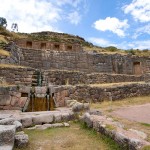Main Highlights: Colonial Cusco landmarks of UNESCO-designated Historic Center: Cusco Cathedral, Koricancha, and Saint Dominique Convent • Sacsayhuaman Archaeological Park: Sacsayhuaman Fortress, Qenqo, Puca Pucara, and Tambomachay
Description: This is a half-day, afternoon tour combining Sacsayhuaman and Cusco Historic Center and it will start visiting the Archaeological Park of Sacsayhuaman. The first stop will be at the Sacsayhuaman Fortress, a beautiful place that radiates peace and quiet, where we will be able to admire the huge rocks measuring up to 4 meters high that were used in its construction. We will then head for Q’enqo, the ancient temple of the Puma, where we will be able to appreciate an altar for sacrifices, and then will continue on to Tambomachay, the sacred fountains of life and health. On the way we will have a panoramic view from Puca Pucara, a watchtower that controlled the entrance to the city. After that we will visit the Temple of the Sun, known as Korikancha, on top of which the Saint Dominique Convent was built. A legend tells that his temple was entirely lined in gold sheets that marveled the Conquistadors upon their arrival. Finally, we will go to the Main Square and will visit the Cathedral that reassures invaluable colonial paintings and other works of art such as the Cross that arrived with the first conquistadors.
Important Note: People are not allowed to enter religious sites wearing shorts. Taking photos is not allowed inside the Cathedral.
Cusco City Tour and Sacsayhuaman
No posts found







